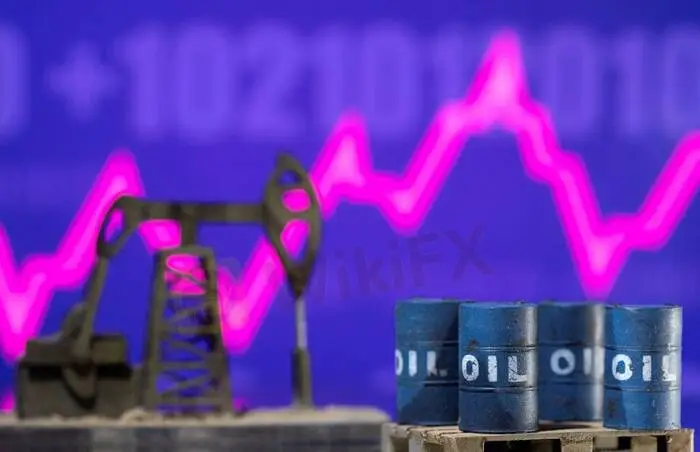简体中文
繁體中文
English
Pусский
日本語
ภาษาไทย
Tiếng Việt
Bahasa Indonesia
Español
हिन्दी
Filippiiniläinen
Français
Deutsch
Português
Türkçe
한국어
العربية
Asian stocks, oil sink as U.S. weighs reserves release
Abstract:Asian stocks on Thursday eased after this week’s global rally, following Wall Street’s overnight stumble, while oil dropped sharply as the United States weighed a massive draw from its reserves to rein in surging fuel prices.
Oil prices dove on Thursday as the United States weighed its largest-ever drawdown from its oil reserves, while Asian stocks fell as China reported weak manufacturing data and uncertainty over the war in Ukraine dragged on.

The United States is considering releasing up to 180 million barrels of oil over several months from strategic reserves, four U.S. sources said, as the White House tries to lower fuel prices that have surged since Russia invaded Ukraine late last month.
Brent crude futures were down 4.9% at $107.89 a barrel and U.S. crude futures fell more than 5% to $101.37 a barrel by midday.
Lower oil prices looked set boost European and U.S. markets at the open with European futures rising 0.49%, Germanys DAX futures gaining 0.61%, Nasdaq futures up 0.4% and S&P500 futures 0.15% higher.
But shares in Asia were hurt by data showing that activity in China‘s the factory and services sectors swung into negative territory in March, contracting simultaneously for the first time since the peak of the country’s COVID-19 outbreak in 2020.
MSCI‘s broadest index of Asia-Pacific shares outside Japan fell 0.56%, led by a 1% drop for Hong Kong’s Hang Seng Index, and a 0.77% decline for Chinese blue chips.
“The sharp declines (in activity) were largely due to the surging Omicron transmission and corresponding stringent measures in major cities,” Chaoping Zhu, a global market strategist for J.P. Morgan Asset Management in Shanghai said in a note, adding that the financial pressures this puts on businesses and households means investors can expect “further monetary supportive measures”.
The euro held at a one-month high against the dollar on Thursday, having rallied on hopes the war in Ukraine might be entering a new de-escalating phase, while the yen was set for its worst month since November 2016.
The European single currency rose as high as $1.1175 in early trade its highest in a month, having gained 1.7% so far this week.
UNCERTAINTY REMAINS
Overnight, the Dow Industrial Average, the S&P 500 and the Nasdaq Composite were down, following similar downward movements in European stocks.
“In U.S. markets, which we take our cue from, the sell-offs are reflecting an ongoing assessment of inflation threats and what the Fed is going to do about it,” said Rob Carnell, chief economist at ING in Singapore.
“At the same time, in the last 24 hours, markets have responded cautiously positively to events in Ukraine, with Russia refocusing away from Kyiv, but things are still looking quite uncertain.”
Bond markets were smouldering after a stinging sell off.
Two-year Treasury yields, which track policy expectations, were last at 2.23164% and have climbed more than 150 basis points for the quarter – the steepest such rise since 1984 on expectations of quick-fire interest rate hikes.
The yield on the 10-year Treasury note, which is more sensitive to the outlook for long-term growth, was last at 2.3562% after hitting 2.56% on Monday, the highest since May 2019.
Inflation continues to squeeze governments and central banks around the world. Germany registered a whopping 7.6% inflation rate on Wednesday, sending its 2-year bond yield into positive territory for the first time since 2014.
Spot gold was down slightly, 0.63%, at $1,920.91 an ounce. [GOL/]
(Editing by Lincoln Feast)
Disclaimer:
The views in this article only represent the author's personal views, and do not constitute investment advice on this platform. This platform does not guarantee the accuracy, completeness and timeliness of the information in the article, and will not be liable for any loss caused by the use of or reliance on the information in the article.
WikiFX Broker
Latest News
CWG Markets Got FSCA, South Africa Authorisation
Amazon launches Temu and Shein rival with \crazy low\ prices
CySEC Warns Against Unauthorized Investment Firms in Cyprus
Revolut X Expands Crypto Exchange Across Europe, Targeting Pro Traders
Crypto Scammer Pleads Guilty in $73 Million “Pig Butchering” Fraud
Capital.com Shifts to Regional Leadership as CEO Kypros Zoumidou Steps Down
Broker Review: Is Exnova Legit?
Why Even the Highly Educated Fall Victim to Investment Scams?
Warning Against Globalmarketsbull & Cryptclubmarket
FBI Raids Polymarket CEO’s Home Amid 2024 Election Bet Probe
Currency Calculator


